MARIANI’SVirtual
Gourmet
April
20, 2014
NEWSLETTER
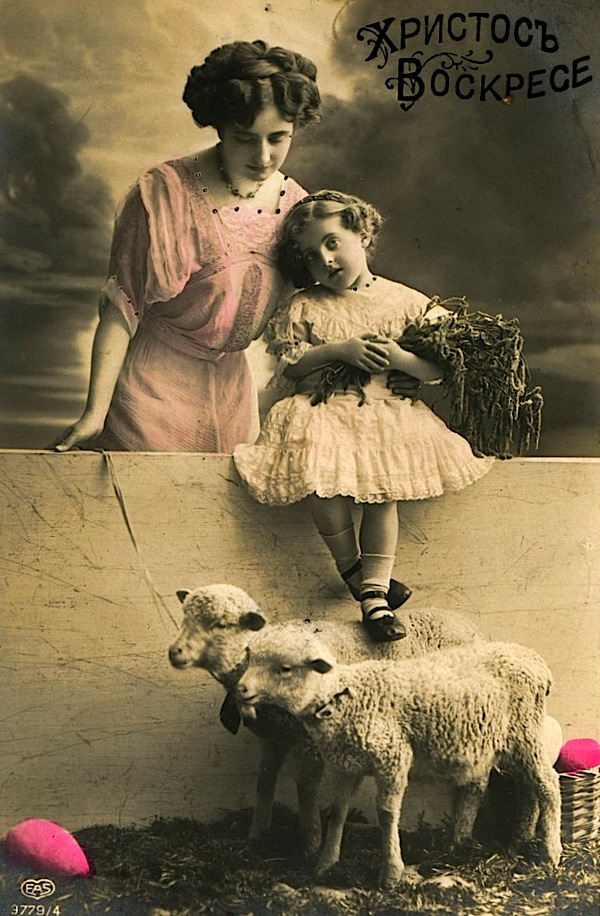
❖❖❖
IN THIS ISSUE
BIG D Throws a Texas-Sized
Food and Wine Party
By John Mariani
NEW YORK CORNER
All'Onda
By John Mariani
❖❖❖
BIG D Throws a Texas-Sized
Food and Wine Party
By John Mariani
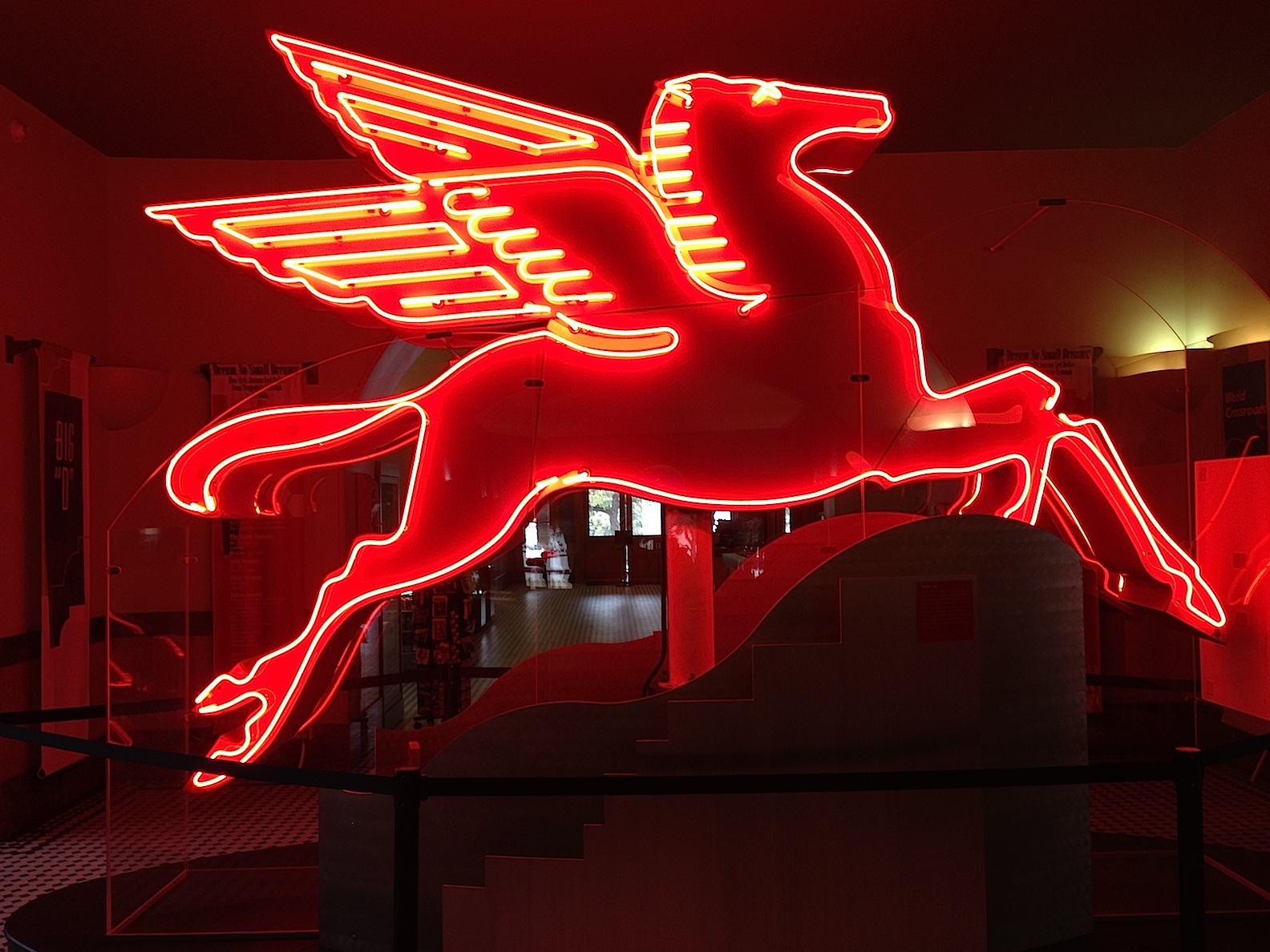
After
decades of dismissing the idea of taking a
guided city tour, I have now come around to
believe that, with the proper guide, I can
learn a whole lot more in a shorter period of
time than if I did my own expeditions,
guidebook in hand, around a vast city like
Dallas.
I
had not just a proper guide but a fellow whose
exuberance and intimate knowledge of the city
opened my eyes not only to what was historical
about Dallas but what is new and exciting, all
against a background of how this wheeling,
dealing Texas town grew into what it is today.
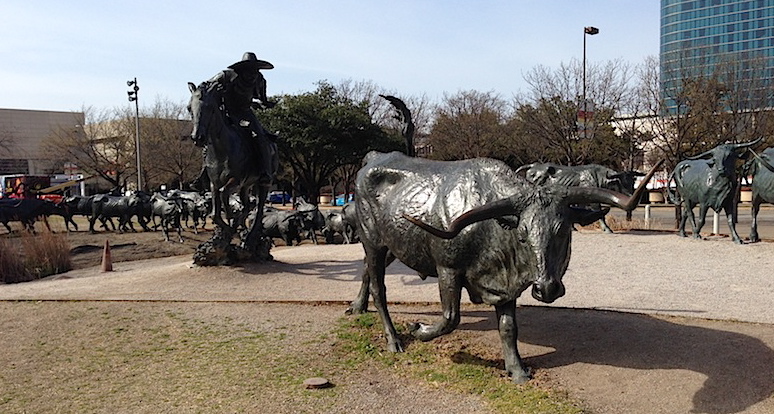 His name was John
Estes and he works for Discover
Dallas Tours, and over a period of
three hours I learned more than I ever had,
despite my having visited the city a score of
times since the 1970s. His detailed
knowledge of the Kennedy assassination,
delivered at the spot where it happened, gave
me insights I’d never considered before, and
his anecdotes about everything from the great
red neon horse that stands in the Old Red Museum
(it became the mascot symbol of Mobil Oil) to
the development of newly gentrifying
neighborhoods and the quirky grandeur of the
ultra-opulent Highland Park showed me just how
diverse the city has become. The
information about the 70 bronze statues of a
cattle herd in Pioneer Park (above) by
Texas artist Robert Summers and the myriad
museums by some of the biggest international
names in architecture was fascinating, right
down to how the unexpectedly harsh sunlight
reflected from a new condo is compromising the
exteriors of sculptures in the Renzo
His name was John
Estes and he works for Discover
Dallas Tours, and over a period of
three hours I learned more than I ever had,
despite my having visited the city a score of
times since the 1970s. His detailed
knowledge of the Kennedy assassination,
delivered at the spot where it happened, gave
me insights I’d never considered before, and
his anecdotes about everything from the great
red neon horse that stands in the Old Red Museum
(it became the mascot symbol of Mobil Oil) to
the development of newly gentrifying
neighborhoods and the quirky grandeur of the
ultra-opulent Highland Park showed me just how
diverse the city has become. The
information about the 70 bronze statues of a
cattle herd in Pioneer Park (above) by
Texas artist Robert Summers and the myriad
museums by some of the biggest international
names in architecture was fascinating, right
down to how the unexpectedly harsh sunlight
reflected from a new condo is compromising the
exteriors of sculptures in the Renzo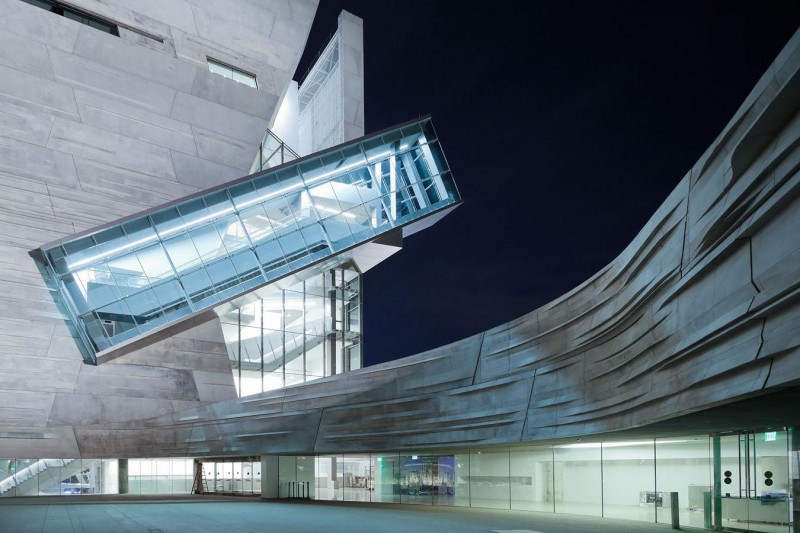 Piano-designed Nasher Museum.
The newest is
the Perot
Museum of Science and Nature (right),
designed as a big floating chunk of recycled
materials by architect Thom Mayne.
Piano-designed Nasher Museum.
The newest is
the Perot
Museum of Science and Nature (right),
designed as a big floating chunk of recycled
materials by architect Thom Mayne.
I was in Dallas, for the second time, to
attend one of this country’s premier wine,
food and art events, Savor Dallas, founded a
decade ago by Jim White and Vicki
Briley-White, who have moved the increasingly
popular event from the Irving Convention
Center in Las Collinas to the new Dallas
Convention Center, which is attached with an
umbilical walkway to the huge, new Omni Dallas
Hotel.
An
enchanting part of the weekend’s events was
the Arts District Wine Stroll, featuring wines
from 23 different wineries, with food stops
along the way at Nasher Sculpture Center and
Meyerson Symphony Center, including many
colorful food trucks.
 The
kick-off was at the Dallas
Arboretum and Botanical Gardens (left), an
extraordinary 66 acres of impeccably tended
landscape and flower sculptures. Here,
local chefs served up hors d’ oeuvres and
vintners poured wines, the strolling attendees
serenaded by a fine jazz band. It’s a
good way to get familiar with the vibrant
Texas wine industry, including labels Fall
Creek Vineyards, Becker Vineyards, Messina Hof
and Kiepersol Estate.
The
kick-off was at the Dallas
Arboretum and Botanical Gardens (left), an
extraordinary 66 acres of impeccably tended
landscape and flower sculptures. Here,
local chefs served up hors d’ oeuvres and
vintners poured wines, the strolling attendees
serenaded by a fine jazz band. It’s a
good way to get familiar with the vibrant
Texas wine industry, including labels Fall
Creek Vineyards, Becker Vineyards, Messina Hof
and Kiepersol Estate.
Wine and serious eno-talk took place the next
day at the “Winemaker’s Tasting Panel” in
the hotel’s steak house. where participants
listened to panelists from various global wine
regions, including Chile, Germany, Texas and
California, followed that evening by a truly
impressive wine tasting of reserve wines,
including several I’ve never seen poured with
such generosity, like Château Cos d’
Éstournel 2008 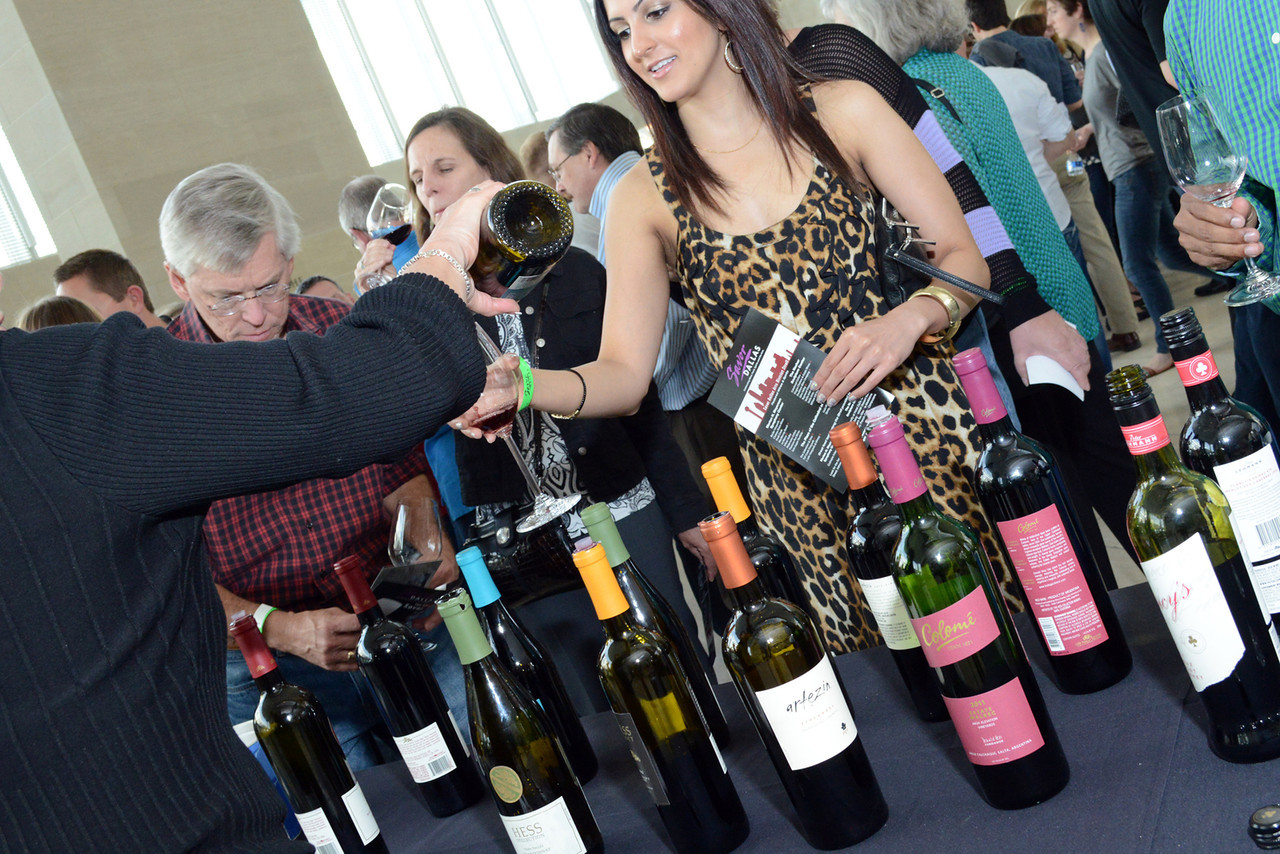 and
Ruffino Greppone Mazzi Brunello di Montalcino
2007.
and
Ruffino Greppone Mazzi Brunello di Montalcino
2007.
The Saturday evening
highlight of the oversubscribed weekend was
the International Grand Tasting (right)
that featured scores of chefs’ tables and
wines rarely if ever brought together in one
huge convention hall. But then, Texas
never does anything small.
. . . AND FOR SOME
‘CUE?
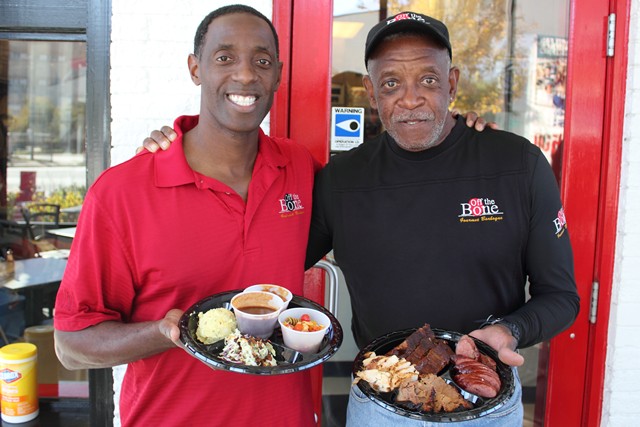 To my
rescue come two places new to me: Off the Bone
and Sammy’s, which are as good as Sonny’s ever
was but go their own way too.
To my
rescue come two places new to me: Off the Bone
and Sammy’s, which are as good as Sonny’s ever
was but go their own way too.Off the Bone (1734 S Lamar Street; 214-565-9551) is a small spot just outside of downtown where you order from a cramped counter then sit and salivate for a few moments before your lightly smoked brisket and ribs, prepared by owner Dwight Harvey (left), arrive. You can have the brisket chopped or sliced in generous proportions, and they go well with combo platters of smoked beef sausage and pulled pork onto which you shake the sauce. The baked beans and cole slaw are O.K., but I hadn't the appetite for triple chocolate pecan cake.
Sammy’s (2126 Leonard Street; 214-880-9064), just behind the Federal Building, is my new favorite barbecue place, though. It's bigger than Off the Bone, more user friendly--you go up and get your own food and then sit down to big tables, affix your bib,
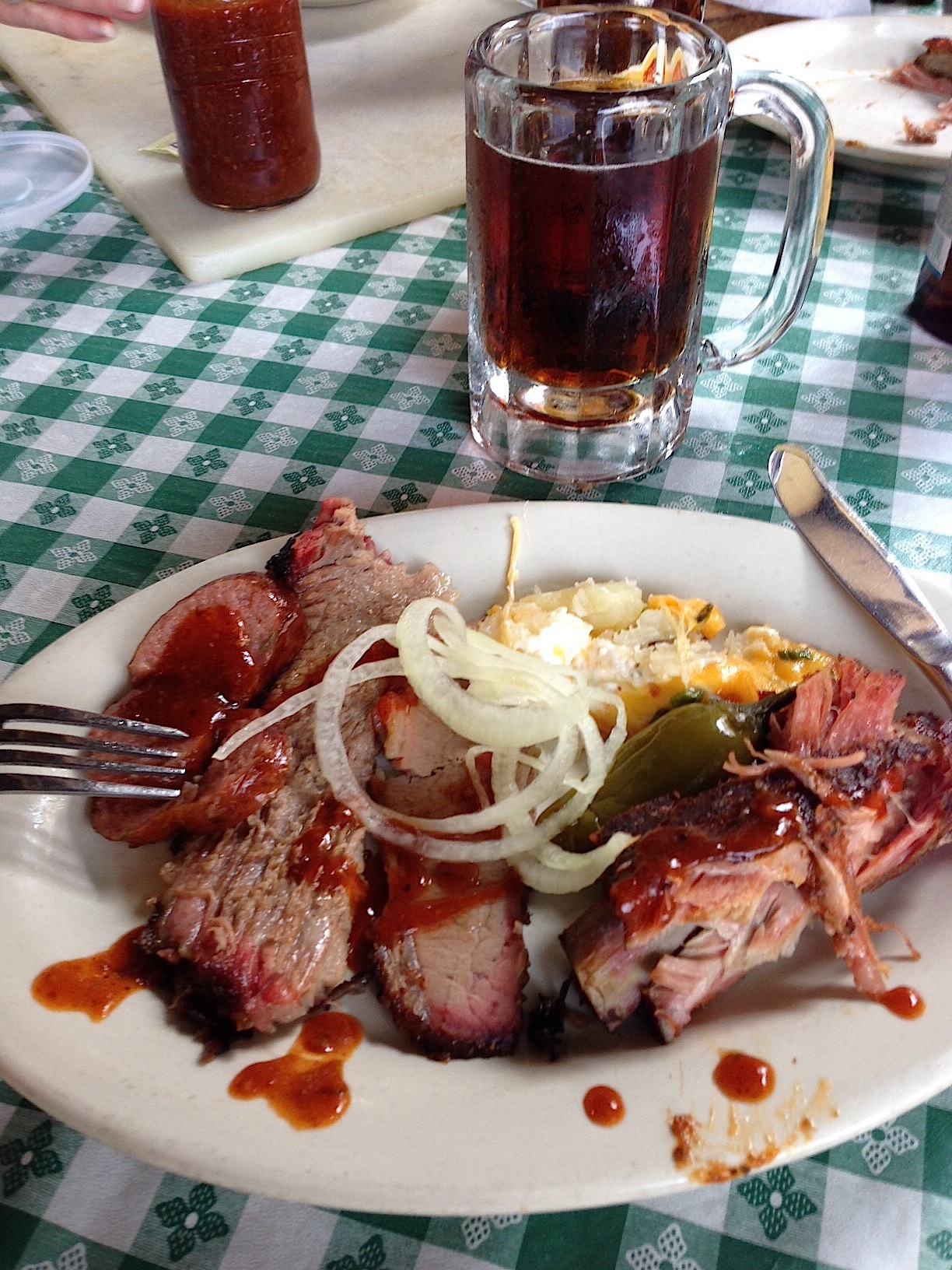 shake
your head wondering where to start, then dig in.
shake
your head wondering where to start, then dig in.
Owner Marshall Prichard is likely to be around asking you how you like his food. The ribs are very good, very meaty and well-fatted, the sausage has a snap to it, and the chicken’s a diversion. Pop one of the fried okra in your mouth and you’ll pop ten more, fast. Aunt Glenda’s potato and cheese casserole is the soul of the South. But Sammy’s is like no other BBQ in town for the deep, rich, very juicy flavor of its beef brisket (right), which might be a dead ringer for the pastrami at Katz’s Deli in NYC. I was really amazed how delicious Sammy’s brisket was, and, though the place is known for his lean brisket, don’t even think of not ordering the fatty version. If you die that day, you’ll already have had a taste of paradise.
The pecan pie, not tioo sweet, is a good way to end.
Only problem is that Sammy’s is only open from 11 AM till 3 PM Monday through Saturday. They have one customer who comes every day Sammy’s is open, and I suspect he takes leftovers home for dinner. That borders on the fanatical, but it’s pretty rare to find ‘que this good anywhere.
A Report on Dallas' New Restaurants will be published in an upcoming issue of the Virtual Gourmet.
❖❖❖
By John Mariani
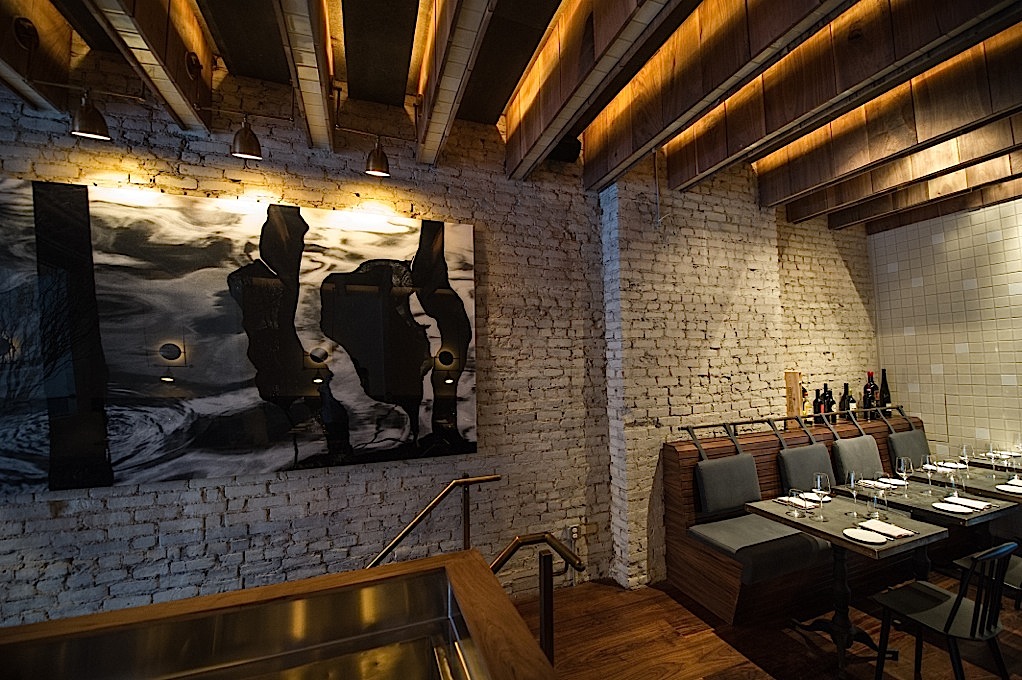 All'Onda
All'Onda22 East 13th Street
212-231-2236
http://allondanyc.com
When
the word was out that veteran restaurateur Chris
Cannon and Chef Chris Jaeckle were going to open a
Venetian-Japanese restaurant, not a few, including
myself, arched an eyebrow. Not because there
aren’t correlations between the seafood cookery of
Venice and that of Japan, but because fusion
cuisine, though more rife than ever, seems a tad
passé at a time when all the media hype is
being spilled on molecular and modernist
gimmickry.
Were all’Onda (“of the wave”)
opened by anyone else, suspicions of intent would
have been aroused, but the two Chrises have a lot
of background in this kind of cuisine: both had
been part of the Altamarea Group headed by Michael
White, which gave New York the great Italian
seafood restaurant Marea, which had its own sushi
(or crudi)
bar. Cannon and Jaeckle split from that
group three years ago and restless foodies were
waiting to see what they would do. It took a
while.
All’Onda is a two-tier affair,
with a barn-like use of old wood and brass, and
windows overlooking the street. Downstairs
is the bar (serving exotic cocktails), upstairs a
dark dining room, both crashingly loud, so you
need to shout to be heard by anyone at your table.
Cannon strides genially through
the restaurant in a quilted jacket, and he is
certainly familiar with many of his customers.
Jaeckle, when chef de cuisine, was more in the
background at Marea, but he makes his appearances
at all’Onda when things aren’t too hectic.
Despite Jaeckle’s having worked
with these kinds of culinary ideas before, it’s
not easy to pull off everything with aplomb if
just about every dish is a novelty. This is
not a place to have a hearty bowl of risotto with
cuttlefish ink or slabs of calf’s liver alla veneziana.
Each dish is cannily transformed in some
way, so that razor clams come with sopressata and
miso ($11), while a scallop couples with anchovy,
cauliflower and lardo fat ($17).
Tuna is paired with Cerignola
olives and preserved tomato but given a shot of
mild wasabi ($16), while sweetbreads are tossed in
with celeriac, a balsamic sugo and bonito ($17).
There are, of course, crudo items available
($13-$18).
The pastas ($17-$19)
mostly succeed admirably. The risotto with
cuttlefish is enhanced with some radicchio and
slivers of saline bottarga, probably the closest
thing to a Venetian rendering on the menu, and it
works. Spaghetti with Manila clams and
Calabrian chile is a traditional trope, and a shot
of bittersweet Ramazzotti doesn’t really add
anything. But the addition of chocolate does give
a noticeable boost to rigatoni with a duck ragù and
Treviso radicchio. Tortellini in a “parmesan
dashi,” with tomato oil and mushroom doesn’t quite
connect the Venetian-Japanese dots.
 Excellent indeed was
guinea hen with parsnip, shio kombu (dried kelp),
and a foie gras
sugo ($27), as was dorade with a
Mediterranean tapenade, pickled chilies and salsa verde
($28), while monkfish with sea urchin (Jaeckle
uses a lot of sea urchin) and polenta with squid
ink and arugula was about two ingredients too much
($25). Jerusalem artichokes with brown butter and
soy sauce were delicious ($7), and Brussels
sprouts took well to a bracing cinder vinegar,
honey, curry and pistachios ($7).
Excellent indeed was
guinea hen with parsnip, shio kombu (dried kelp),
and a foie gras
sugo ($27), as was dorade with a
Mediterranean tapenade, pickled chilies and salsa verde
($28), while monkfish with sea urchin (Jaeckle
uses a lot of sea urchin) and polenta with squid
ink and arugula was about two ingredients too much
($25). Jerusalem artichokes with brown butter and
soy sauce were delicious ($7), and Brussels
sprouts took well to a bracing cinder vinegar,
honey, curry and pistachios ($7).
I wish for more enticing
desserts than olive oil cake (at an absurd $13)--a
trendy idea among chefs--with lemon and basil, or
a panna cotta
($12) with fennel and the gag-causing
Fernet-Branca digestive most people drink as a
punishment for overindulgence. Let’s just
forget the soy sauce gelato.
It’s not easy to match wine
with this kind of food, so ask sommelier Nathan
Rawlinson for help. He’s got plenty of interesting
wines, especially whites, that marry well.
All’Onda has thus far drawn a
surging crowd of adventurous foodies, but it will
be interesting to see if many will return again
and again for this particular style of cuisine.
I suspect it will evolve, tame down some of
its odder components, like Ramazotti and
Fernet-Branca, and become one of those places fans
will bring out-of-towners for something they’re
not likely to find back home.
Hours: Lunch Mon.-Fri. ; Dinner:
Sun.-Thur., 5:30-11 p.m.; Fri.-Sat., 5:30
p.m.-midnight
❖❖❖
COLD CASE

A French court ruled that cold poultry
constitutes a weapon, after a
35-year-old man launched a frozen chicken attach on his
girlfriend after showed up
at her house in Luxeuil-les-Bains while intoxicated. An
argument ensued and man
grabbed a frozen chicken from the
freezer and hit her with the bird. The assailant was
sentenced to 24 months in prison. The man had reportedly
been convicted of violence against the same woman twice
before.
 MAYBE NO ONE WILL NOTICE?
MAYBE NO ONE WILL NOTICE?Travel and Leisure Magazine listed 15 "Best New Restaurants" in its current issue, even though more than half have not yet opened.
Any of John Mariani's
books below may be ordered from amazon.com.
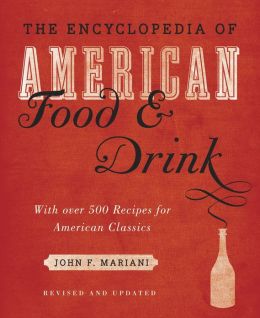 |
The Encyclopedia of American Food and Drink by John F. Mariani (Bloomsbury USA, $35) Modesty forbids me to praise my own new book, but let me proudly say that it is an extensive revision of the 4th edition that appeared more than a decade ago, before locavores, molecular cuisine, modernist cuisine, the Food Network and so much more, now included. Word origins have been completely updated, as have per capita consumption and production stats. Most important, for the first time since publication in the 1980s, the book includes more than 100 biographies of Americans who have changed the way we cook, eat and drink -- from Fannie Farmer and Julia Child to Robert Mondavi and Thomas Keller. "This book is amazing! It has entries for everything from `abalone' to `zwieback,' plus more than 500 recipes for classic American dishes and drinks."--Devra First, The Boston Globe. "Much needed in any kitchen library."--Bon Appetit. |
"Eating Italian will never be the same after reading John Mariani's entertaining and savory gastronomical history of the cuisine of Italy and how it won over appetites worldwide. . . . This book is such a tasteful narrative that it will literally make you hungry for Italian food and arouse your appetite for gastronomical history."--Don Oldenburg, USA Today. "Italian
restaurants--some good, some glitzy--far
outnumber their French rivals. Many of
these establishments are zestfully described
in How Italian Food Conquered the World, an
entertaining and fact-filled chronicle by
food-and-wine correspondent John F.
Mariani."--Aram Bakshian Jr., Wall Street
Journal.
"Equal parts
history, sociology, gastronomy, and just
plain fun, How Italian Food Conquered the
World tells the captivating and delicious
story of the (let's face it) everybody's
favorite cuisine with clarity, verve and
more than one surprise."--Colman Andrews,
editorial director of The Daily
Meal.com. "A fantastic and fascinating
read, covering everything from the influence
of Venice's spice trade to the impact of
Italian immigrants in America and the
evolution of alta cucina. This book will
serve as a terrific resource to anyone
interested in the real story of Italian
food."--Mary Ann Esposito, host of PBS-TV's
Ciao
Italia. "John Mariani has written the
definitive history of how Italians won their
way into our hearts, minds, and
stomachs. It's a story of pleasure over
pomp and taste over technique."--Danny Meyer,
owner of NYC restaurants Union Square
Cafe, The Modern, and Maialino.
|
 |
 |
 |
 |
 |
 |
 |
 |
 Everett Potter's Travel Report:
Everett Potter's Travel Report: 
 Eating Las Vegas
is the new on-line site for Virtual Gourmet
contributor John A. Curtas., who since 1995
has been commenting on the Las Vegas food
scene and reviewing restaurants for Nevada
Public Radio. He is also the
restaurant critic for KLAS TV, Channel 8 in
Las Vegas, and his past reviews can be
accessed at KNPR.org.
Click on the logo below to go directly to
his site.
Eating Las Vegas
is the new on-line site for Virtual Gourmet
contributor John A. Curtas., who since 1995
has been commenting on the Las Vegas food
scene and reviewing restaurants for Nevada
Public Radio. He is also the
restaurant critic for KLAS TV, Channel 8 in
Las Vegas, and his past reviews can be
accessed at KNPR.org.
Click on the logo below to go directly to
his site.

Tennis Resorts Online: A Critical Guide to the World's Best Tennis Resorts and Tennis Camps, published by ROGER COX, who has spent more than two decades writing about tennis travel, including a 17-year stretch for Tennis magazine. He has also written for Arthur Frommer's Budget Travel, New York Magazine, Travel & Leisure, Esquire, Money, USTA Magazine, Men's Journal, and The Robb Report. He has authored two books-The World's Best Tennis Vacations (Stephen Greene Press/Viking Penguin, 1990) and The Best Places to Stay in the Rockies (Houghton Mifflin, 1992 & 1994), and the Melbourne (Australia) chapter to the Wall Street Journal Business Guide to Cities of the Pacific Rim (Fodor's Travel Guides, 1991).


MARIANI'S VIRTUAL GOURMET
NEWSLETTER is published weekly. Editor/Publisher: John
Mariani.
Editor: Walter Bagley. Contributing Writers: Christopher Mariani,
Robert Mariani, John A.
Curtas, Edward Brivio, Mort Hochstein, Suzanne
Wright, and Brian Freedman. Contributing
Photographers: Galina Stepanoff-Dargery,
Bobby Pirillo. Technical Advisor: Gerry McLoughlin.
© copyright John Mariani 2014
